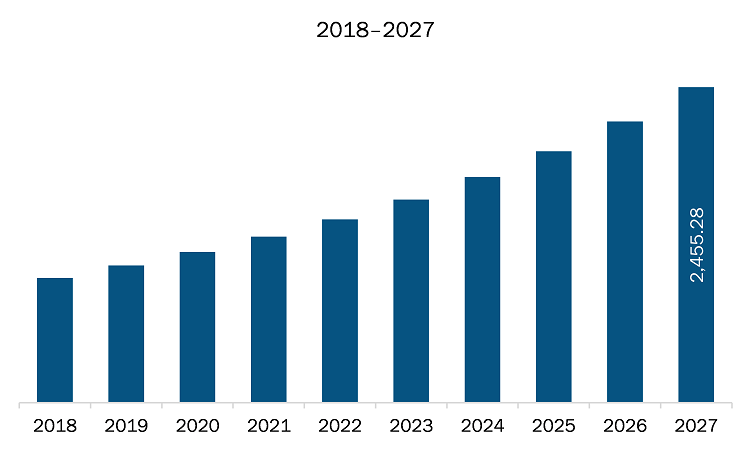The hypertrophic and keloid scar treatment market in Asia-Pacific is expected to grow from US$ 1,173.23 million in 2020 to US$ 2,455.28 million by 2027; it is estimated to grow at a CAGR of 11.1% from 2020 to 2027.
China, Japan, and India are major economies in Asia-Pacific. Tapping market in emerging countries is the major factor driving the growth of the Asia-Pacific hypertrophic and keloid scar treatment market. Various emerging countries in Asia-Pacific have reported a maximum number of burn cases. According to the WHO, globally, ~180,000 deaths are reported due to burns, and Southeast Asia regions account for the one-third of the total burn fatalities. However, there are several disparities in hypertrophic and keloid scars treatments across this region. The treatment procedures are mainly based on the understanding of the pathological mechanisms that underlie these fibrotic skin diseases. The disparities due to ethnicities create challenges for the physicians to prescribe a treatment. In addition, uncertain diagnostics and unclear treatment guidelines may also lead to disparities offering treatments to people with different pathological of genetic makeup. Hence, a particular treatment may result in different outcomes. To meet such challenges associated with diagnosis and treatment, Japan Scar Workshop (JSW) has introduced a JSW Scar Scale (JSS) tool that allows clinicians to accurately diagnose and differentiate between keloids, hypertrophic scars, and mature scars. The tool involves scoring the risk factors of the different patients and their affected sites. The JSW has also published a Consensus Document, which describes the guidelines and treatments. It is likely to be helpful in Asia Pacific. Therefore, disparities in the treatment procedures are likely to offer vital growth opportunities for the hypertrophic and keloid scar treatment market players to expand their business, which is further anticipated to drive the market in Asia-Pacific.
Asia-Pacific countries are expecting to witness a huge challenge due to the increasing prevalence of COVID-19. Due to the outbreak of disease, healthcare industries have been affected badly, considering the economic conditions in the current situation. Due to the increasing COVID-19 cases, the cost for many treatments has been lowered. Considering the economic operations and geographic condition, the outbreak of the disease has affected medical tourism, manufacturers of medical equipment, laser systems, accessories, and other problems posed by the shortage of healthcare infrastructure in Asia-Pacific low-income countries. After the first case in December 2019 in Wuhan, China, the COVID-19 has spread to at least 180 countries and regions. To prevent the spread of disease, restrictive measures have been taken in countries such as India, South Korea, Singapore, Malaysia, and the Philippines. According to the World Health Organization (WHO), due to the rapidly changing risk of COVID-19 affected countries and constantly controlling outbreak trends, any additional health measures are likely to interfere with international travel and trade significantly. Countries such as Japan and Australia are conducting virtual international conferences to anticipate the impact of COVID-19 on the cosmetic industry in the Asia Pacific. The ongoing COVID-19 pandemic has created a seismic shift in living and cosmetic habits in the region, and hypertrophic and keloid scar treatment has borne a significant brunt of this shopper shake-up. China is explicitly facing issues with the pandemic, leading to disruption of the supply chain and projected losses in revenue, marketing, and sales within all industries—especially the hypertrophic and keloid scar treatment—and the concerns of health within the production units and other public places.

- This FREE sample will include data analysis, ranging from market trends to estimates and forecasts.
Asia-Pacific Hypertrophic and Keloid Scar Treatment Market Segmentation
Asia-Pacific Hypertrophic and Keloid Scar Treatment Market – By Scar Type
- Hypertrophic
- Keloid
Asia-Pacific Hypertrophic and Keloid Scar Treatment Market – By Product Type
- Injectables
- Topical
- Gels
- Silicone Sheets
- Creams
- Other
- Laser
- CO2
- Pulse-Dyed
- Other
- Other
Asia-Pacific Hypertrophic and Keloid Scar Treatment Market – By End User
- Hospitals
- Clinics
- Homecare
Asia-Pacific Hypertrophic and Keloid Scar Treatment Market, by Country
- China
- Japan
- India
- South Korea
- Australia
- Rest of Asia-Pacific
Asia-Pacific Hypertrophic and Keloid Scar Treatment Market-Companies Mentioned
- Alliance Pharma PLC
- HRA Pharma
- Mölnlycke Health Care AB.
- Newmedical Technology Inc.
- Perrigo Company plc
- Lumenis
- Smith & Nephew
- Sonoma Pharmaceuticals, Inc
- Suneva Medical
Asia-Pacific Hypertrophic and Keloid Scar Treatment Report Scope
| Report Attribute | Details |
|---|---|
| Market size in 2020 | US$ 1,173.23 Million |
| Market Size by 2027 | US$ 2,455.28 Million |
| CAGR (2020 - 2027) | 11.1% |
| Historical Data | 2018-2019 |
| Forecast period | 2021-2027 |
| Segments Covered |
By Scar Type
|
| Regions and Countries Covered |
Asia-Pacific
|
| Market leaders and key company profiles |
|
- Historical Analysis (2 Years), Base Year, Forecast (7 Years) with CAGR
- PEST and SWOT Analysis
- Market Size Value / Volume - Regional, Country
- Industry and Competitive Landscape
- Excel Dataset
Recent Reports
Testimonials
Reason to Buy
- Informed Decision-Making
- Understanding Market Dynamics
- Competitive Analysis
- Identifying Emerging Markets
- Customer Insights
- Market Forecasts
- Risk Mitigation
- Boosting Operational Efficiency
- Strategic Planning
- Investment Justification
- Tracking Industry Innovations
- Aligning with Regulatory Trends






















 Get Free Sample For
Get Free Sample For